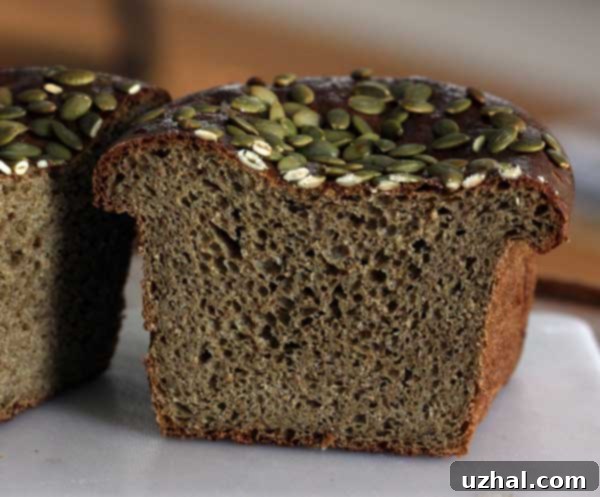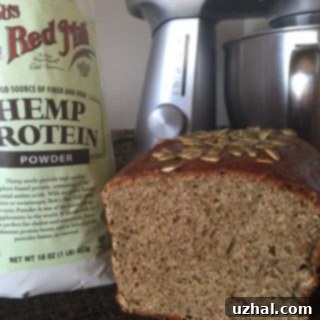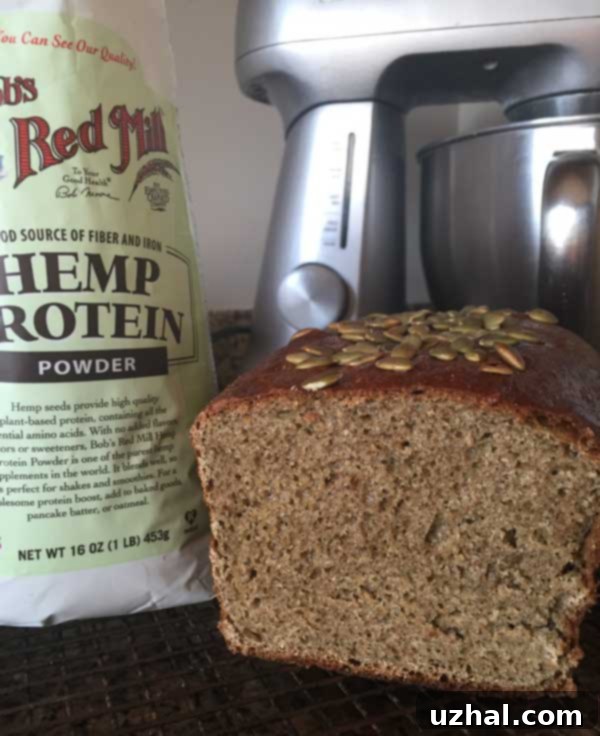Homemade Hemp Protein Bread: A Nutritious Twist on Classic Cornell Bread
The story of nutritious homemade bread often leads back to the renowned Cornell Bread, a staple created in the 1940s by Dr. Clive McKay, a pioneering nutrition professor at Cornell University. In a post-World War II era marked by economic shifts and a renewed focus on public health, Dr. McKay envisioned a bread that was both economical and exceptionally healthful, providing essential nutrients that were often lacking in the average diet. His original formula was revolutionary, incorporating a unique blend of soy flour, nonfat dry milk powder, and wheat germ into everyday bread recipes. These additions significantly boosted the protein, vitamins, and minerals in each slice, making it a powerful tool for improving public nutrition.
Initially, Dr. McKay designed the recipe to be accessible and appealing to the broadest audience possible, which led him to recommend white flour. This choice ensured that the bread resembled the familiar white loaves popular at the time, encouraging widespread adoption even among those hesitant to try new, “health-food” alternatives. However, as the recipe’s fame grew and nutritional awareness evolved, health-conscious bakers and home cooks began to experiment. They naturally gravitated towards substituting a portion, or even all, of the white flour with whole wheat flour, further enhancing the bread’s fiber content and overall nutritional profile. This adaptability is part of what makes Cornell Bread’s legacy so enduring.
Today, the spirit of Cornell Bread continues to inspire bakers to innovate and personalize their loaves. Many modern versions of the recipe maintain the core principles, often combining various flours with the signature blend of soy flour, dry milk, and wheat germ. My personal take on this classic, however, introduces a slightly unconventional, yet incredibly beneficial, twist. When I couldn’t source soy flour, I opted for hemp protein powder, creating what I affectionately call “Hemp Protein Powder Bread.” This substitution not only upholds the high-protein ethos of the original Cornell Bread but also introduces the unique nutritional advantages of hemp, yielding a distinctively delicious and wholesome loaf.

Inspired by Jane Brody: Crafting My Hemp Protein Loaf
My particular recipe for this revitalized Cornell Bread is an evolution from a cherished source: Jane Brody’s widely respected Good Food Book. Jane Brody, a celebrated health and nutrition columnist for The New York Times, has long been a trusted voice in promoting healthy eating through practical, accessible recipes. Her version of Cornell Bread provided an excellent foundation, and I’ve made a few key modifications to suit my preferences and ingredient availability, ultimately creating a bread that we absolutely adore.
Beyond substituting soy flour with nutrient-dense hemp protein powder, I’ve also incorporated a touch of honey. This natural sweetener not only adds a subtle depth of flavor but also acts as a food source for the yeast, contributing to a better rise and a more tender crumb. To make the recipe more manageable for home baking and to ensure a fresh loaf is always on hand without excess, I halved the original recipe, yielding one perfectly sized loaf. This adaptation makes it ideal for smaller households or for those who enjoy baking more frequently.
The resulting bread has become a household favorite. My partner, Fuzz, enjoys it in hearty turkey sandwiches, while I find it utterly delightful as a base for peanut butter toast, especially in the mornings. Thanks to the significant inclusion of hemp protein powder, this bread is noticeably denser than many typical yeast breads. However, this density is far from a drawback; it contributes to a wonderfully satisfying texture that slices neatly without crumbling, making it perfect for both sandwiches and toast. Its flavor profile is pleasantly earthy, subtly nutty from the hemp, and remarkably versatile. A unique visual characteristic of using hemp protein powder is the bread’s intriguing, slightly greenish hue, which lends an artisan quality to the loaf. This earthy color looks especially appealing when topped with a scattering of pumpkin seeds before baking, adding a delightful crunch and visual interest. Below, you can see how the dough appears just before it’s ready to enter the oven, showcasing its rich texture and promising potential.

Versatile Variations: Dairy-Free Options and Baking Insights
Experimentation is key to successful home baking, and after making my Hemp Protein Powder Bread three times, I’ve explored several variations to refine the recipe and cater to different dietary needs. My initial success led me to tackle a common dietary concern: dairy. For those who avoid milk, I’m delighted to confirm that this Hemp Protein Powder Bread recipe is incredibly adaptable. You can easily omit the dry milk powder entirely and replace a portion of the water with almond milk, or any other plant-based milk of your choice. This simple swap makes the bread suitable for vegan or dairy-free diets without compromising on flavor or texture. In fact, one of my batches included this almond milk variation.
During my initial dairy-free experiment, I did notice a slight dip in the top of the loaf, as shown in the accompanying picture. This was largely due to my decision to use a bit less flour in that particular batch (13.5 oz instead of the recommended 15 oz). It served as a valuable lesson in the precision often required in baking. However, I quickly rectified this in a subsequent attempt, making the almond milk variation again with the full 15 oz of flour. The result was a much nicer, more aesthetically pleasing rounded top, demonstrating that while the milk powder can contribute to structure, using the correct flour ratio is paramount.

Despite the minor sinkage in the first almond milk loaf, all of my variations maintained a good texture and were thoroughly enjoyed. This highlights the robustness of the Cornell Bread concept and its ability to adapt to ingredient changes while still producing a delicious result. It’s comforting to know that dietary restrictions don’t have to mean sacrificing the joy of homemade, nutritious bread.
Looking ahead, once we’ve savored every slice of this current batch, I’m eager to try further variations. One recipe that has caught my eye is from Mother Earth News, which promises a sweeter loaf made with 100% whole wheat flour. The idea of a fully whole grain, slightly sweeter bread is very appealing, and I believe the hemp protein powder would integrate beautifully, adding another layer of nutrition and a pleasant earthy note. Jane Brody also has another similar recipe, her “High Protein 3 Grain Bread,” which is sweeter and calls for the addition of oats. Given the success of hemp protein powder in my current iteration, I’m confident it would work exceptionally well in that recipe too, enhancing the protein content and contributing to a wonderfully complex texture and flavor profile. These future experiments promise even more delightful and healthy baking adventures!
For those who are fascinated by the origins and evolution of food and the visionary minds behind them, I highly recommend delving deeper into the history of Dr. Clive McKay and his groundbreaking Cornell Bread. It’s a truly compelling story of how scientific nutrition was brought into the everyday kitchen to benefit the masses. If you don’t have time to bake right now but are interested in this pretty fascinating evolution of a bread recipe, you can find an insightful article about Dr. McCay and his famous bread from the Soy Info Center. It provides a wonderful historical context to why this bread was, and remains, so significant in the world of nutrition and baking.
If you’re looking for more delicious and healthy recipes, especially those featuring wholesome ingredients like hemp protein, check out some of our other favorites:
- Oat, Flax & Hemp Chocolate Chip Cookies
- Yeast Banana Bread
- Raw Hemp Chocolate Chunk Blondies
- Chocolate Chip Peanut Butter Protein Cookies
- Small Batch Banana Muffins with Protein Powder
Recipe

Hemp Protein Powder Bread
Cookie Madness
Pin Recipe
Ingredients
- 1 ½ cups warm water see variation
- 1 packet active dry yeast 2 ¼ teaspoons
- 1 tablespoon vegetable oil
- 1 ½ cups whole wheat flour 7.5 oz — I used the weight, volume is estimate
- 1 ½ cups bread flour 7.5 oz I used the weight, volume is an estimate
- ½ cup hemp protein powder or soy flour
- 1 ½ tablespoons wheat germ
- ¼ cup plus 2 tablespoons dry milk powder see almond milk variation
- 1 teaspoon salt
- 2 tablespoons honey
Instructions
-
Grease an 8 ½ by 4 ½ inch (or a 9×5 inch) loaf pan and line with a strip of parchment, then grease parchment and dust pan with flour. This preparation ensures your loaf doesn’t stick and releases easily after baking.
-
In a small bowl, dissolve the active dry yeast in the warm water and set aside for 5-10 minutes until foamy. This “proofs” the yeast, ensuring it’s active and ready to make your bread rise.
-
In the bowl of a stand mixer fitted with a dough hook, combine the whole wheat flour, bread flour, wheat germ, hemp protein powder (or soy flour), dry milk powder, and salt. Stir these dry ingredients thoroughly to ensure even distribution of all components.
-
Add the activated water/yeast mixture, vegetable oil, and honey to the dry ingredients. Begin mixing on a low speed until everything is just blended. Then, increase the speed and allow the mixer to knead the dough for approximately 7 minutes, or until it becomes smooth, elastic, and pulls away cleanly from the sides of the bowl. Stop after the first minute or two to scrape down the sides of the bowl with a spatula, ensuring all ingredients are fully incorporated. If the dough appears too sticky and isn’t clearing the sides of the bowl, you can sprinkle in a small amount of additional bread flour, a tablespoon at a time, until the desired consistency is achieved. The dough should feel fairly substantial and not excessively tacky.
-
Lightly grease a large bowl with a little oil. Transfer the kneaded dough to this bowl, turning it once to coat all sides. Cover the bowl tightly with plastic wrap or a clean kitchen towel and allow the dough to rise in a warm, draft-free place for about an hour, or until it has doubled in bulk. The exact rising time can vary depending on your kitchen’s temperature and humidity, so always go by visual cues rather than strict timing. This could take anywhere from 60 to 90 minutes.
-
Once doubled, gently punch down the dough to release the air. Turn it out onto a lightly floured surface, shape it into a smooth ball, and then gently form it into a brick shape that fits your prepared loaf pan. Transfer the shaped dough to the loaf pan, seam-side down. Cover the pan again and allow the dough to rise for a second time, for another hour, or until it has noticeably puffed up and reached just above the rim of the pan.
-
Preheat your oven to 350 degrees F (175 degrees C). If desired, for a golden crust and extra flavor, brush the top of the risen loaf with a little egg white (lightly beaten) and sprinkle on some pumpkin or sunflower seeds. This adds a beautiful finish and a delightful crunch.
-
Bake the bread in the preheated oven for approximately 50 minutes. To check for doneness, carefully remove the loaf from the pan (it should easily lift out if well-greased) and tap the bottom. If it sounds hollow, the bread is fully baked. If it doesn’t sound hollow or if the crust isn’t deeply golden, return it to the oven for another 5-10 minutes.
-
Immediately transfer the baked loaf to a wire rack to cool completely. This crucial step prevents the bottom from becoming soggy and allows the internal structure of the bread to set properly. Resist the urge to slice into it too soon! Once fully cooled, slice and enjoy. This recipe yields one generous 30 oz loaf.
Notes
